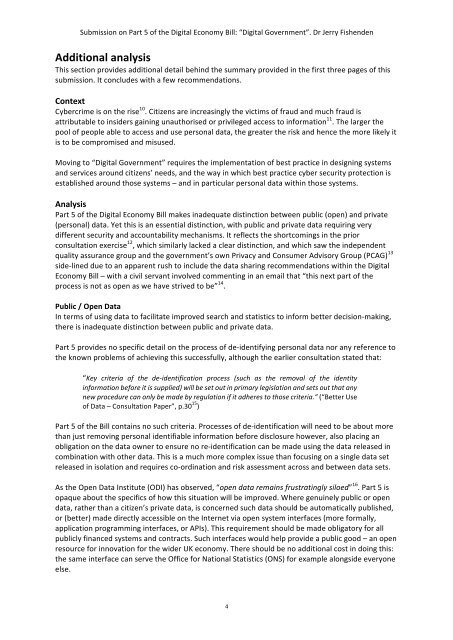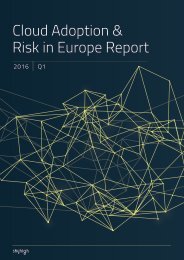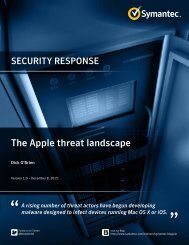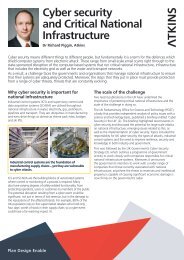Submission on Part 5 of the Digital Economy Bill “Digital Government”
part_5_digital_economy_bill
part_5_digital_economy_bill
You also want an ePaper? Increase the reach of your titles
YUMPU automatically turns print PDFs into web optimized ePapers that Google loves.
<str<strong>on</strong>g>Submissi<strong>on</strong></str<strong>on</strong>g> <strong>on</strong> <strong>Part</strong> 5 <strong>of</strong> <strong>the</strong> <strong>Digital</strong> Ec<strong>on</strong>omy <strong>Bill</strong>: “<strong>Digital</strong> <strong>Government”</strong>. Dr Jerry Fishenden<br />
Additi<strong>on</strong>al analysis<br />
This secti<strong>on</strong> provides additi<strong>on</strong>al detail behind <strong>the</strong> summary provided in <strong>the</strong> first three pages <strong>of</strong> this<br />
submissi<strong>on</strong>. It c<strong>on</strong>cludes with a few recommendati<strong>on</strong>s.<br />
C<strong>on</strong>text<br />
Cybercrime is <strong>on</strong> <strong>the</strong> rise 10 . Citizens are increasingly <strong>the</strong> victims <strong>of</strong> fraud and much fraud is<br />
attributable to insiders gaining unauthorised or privileged access to informati<strong>on</strong> 11 . The larger <strong>the</strong><br />
pool <strong>of</strong> people able to access and use pers<strong>on</strong>al data, <strong>the</strong> greater <strong>the</strong> risk and hence <strong>the</strong> more likely it<br />
is to be compromised and misused.<br />
Moving to “<strong>Digital</strong> <strong>Government”</strong> requires <strong>the</strong> implementati<strong>on</strong> <strong>of</strong> best practice in designing systems<br />
and services around citizens’ needs, and <strong>the</strong> way in which best practice cyber security protecti<strong>on</strong> is<br />
established around those systems – and in particular pers<strong>on</strong>al data within those systems.<br />
Analysis<br />
<strong>Part</strong> 5 <strong>of</strong> <strong>the</strong> <strong>Digital</strong> Ec<strong>on</strong>omy <strong>Bill</strong> makes inadequate distincti<strong>on</strong> between public (open) and private<br />
(pers<strong>on</strong>al) data. Yet this is an essential distincti<strong>on</strong>, with public and private data requiring very<br />
different security and accountability mechanisms. It reflects <strong>the</strong> shortcomings in <strong>the</strong> prior<br />
c<strong>on</strong>sultati<strong>on</strong> exercise 12 , which similarly lacked a clear distincti<strong>on</strong>, and which saw <strong>the</strong> independent<br />
quality assurance group and <strong>the</strong> government’s own Privacy and C<strong>on</strong>sumer Advisory Group (PCAG) 13<br />
side-lined due to an apparent rush to include <strong>the</strong> data sharing recommendati<strong>on</strong>s within <strong>the</strong> <strong>Digital</strong><br />
Ec<strong>on</strong>omy <strong>Bill</strong> – with a civil servant involved commenting in an email that “this next part <strong>of</strong> <strong>the</strong><br />
process is not as open as we have strived to be” 14 .<br />
Public / Open Data<br />
In terms <strong>of</strong> using data to facilitate improved search and statistics to inform better decisi<strong>on</strong>-making,<br />
<strong>the</strong>re is inadequate distincti<strong>on</strong> between public and private data.<br />
<strong>Part</strong> 5 provides no specific detail <strong>on</strong> <strong>the</strong> process <strong>of</strong> de-identifying pers<strong>on</strong>al data nor any reference to<br />
<strong>the</strong> known problems <strong>of</strong> achieving this successfully, although <strong>the</strong> earlier c<strong>on</strong>sultati<strong>on</strong> stated that:<br />
“Key criteria <strong>of</strong> <strong>the</strong> de-identificati<strong>on</strong> process (such as <strong>the</strong> removal <strong>of</strong> <strong>the</strong> identity<br />
informati<strong>on</strong> before it is supplied) will be set out in primary legislati<strong>on</strong> and sets out that any<br />
new procedure can <strong>on</strong>ly be made by regulati<strong>on</strong> if it adheres to those criteria.” (“Better Use<br />
<strong>of</strong> Data – C<strong>on</strong>sultati<strong>on</strong> Paper”, p.30 15 )<br />
<strong>Part</strong> 5 <strong>of</strong> <strong>the</strong> <strong>Bill</strong> c<strong>on</strong>tains no such criteria. Processes <strong>of</strong> de-identificati<strong>on</strong> will need to be about more<br />
than just removing pers<strong>on</strong>al identifiable informati<strong>on</strong> before disclosure however, also placing an<br />
obligati<strong>on</strong> <strong>on</strong> <strong>the</strong> data owner to ensure no re-identificati<strong>on</strong> can be made using <strong>the</strong> data released in<br />
combinati<strong>on</strong> with o<strong>the</strong>r data. This is a much more complex issue than focusing <strong>on</strong> a single data set<br />
released in isolati<strong>on</strong> and requires co-ordinati<strong>on</strong> and risk assessment across and between data sets.<br />
As <strong>the</strong> Open Data Institute (ODI) has observed, “open data remains frustratingly siloed” 16 . <strong>Part</strong> 5 is<br />
opaque about <strong>the</strong> specifics <strong>of</strong> how this situati<strong>on</strong> will be improved. Where genuinely public or open<br />
data, ra<strong>the</strong>r than a citizen’s private data, is c<strong>on</strong>cerned such data should be automatically published,<br />
or (better) made directly accessible <strong>on</strong> <strong>the</strong> Internet via open system interfaces (more formally,<br />
applicati<strong>on</strong> programming interfaces, or APIs). This requirement should be made obligatory for all<br />
publicly financed systems and c<strong>on</strong>tracts. Such interfaces would help provide a public good – an open<br />
resource for innovati<strong>on</strong> for <strong>the</strong> wider UK ec<strong>on</strong>omy. There should be no additi<strong>on</strong>al cost in doing this:<br />
<strong>the</strong> same interface can serve <strong>the</strong> Office for Nati<strong>on</strong>al Statistics (ONS) for example al<strong>on</strong>gside every<strong>on</strong>e<br />
else.<br />
4





